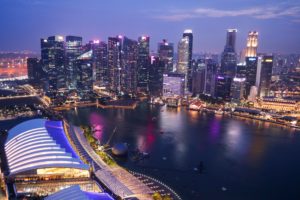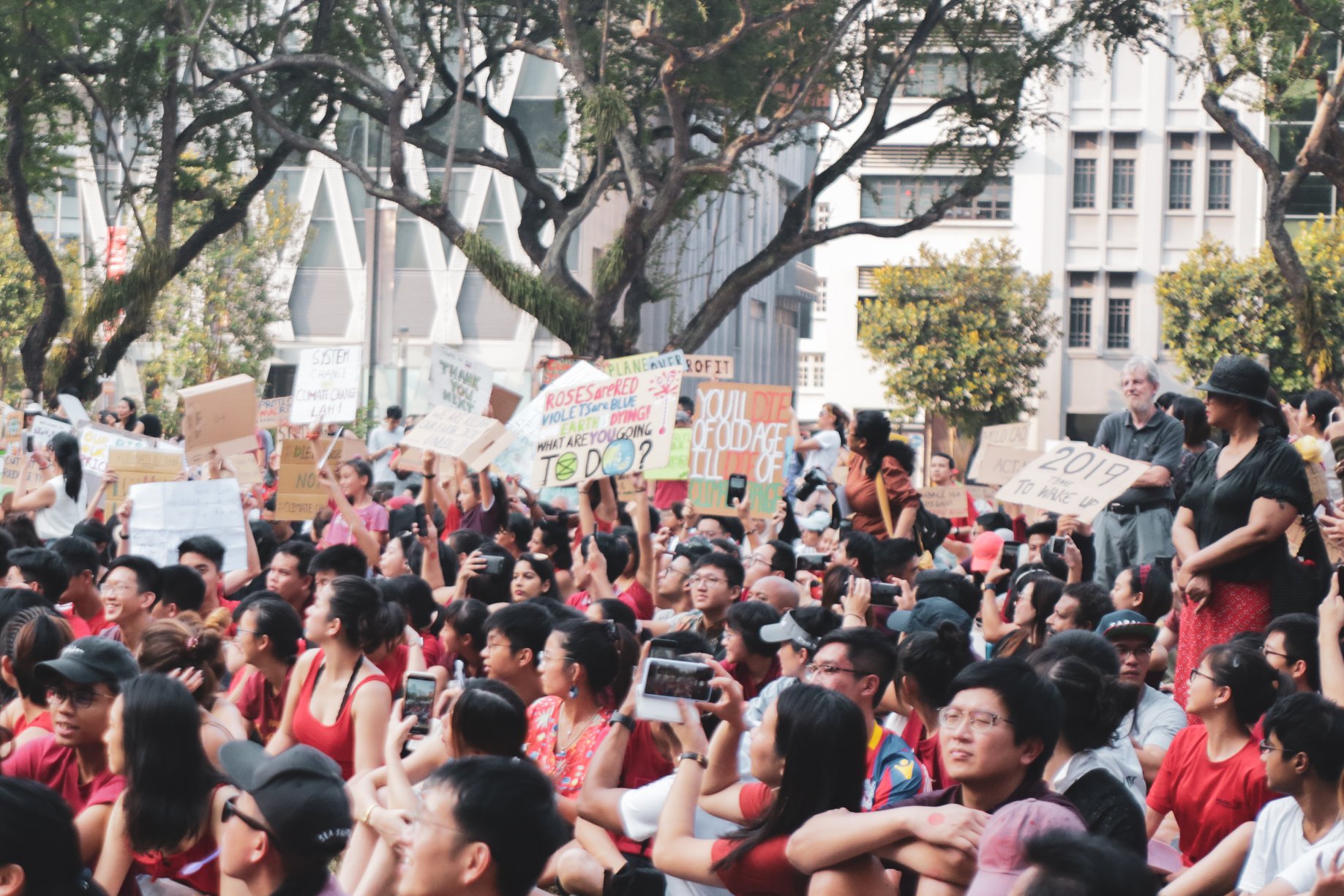Today is Youth Day at COP26. Youths all over the world are, and have been, rising up to the challenge, and taking leaders to account. In Singapore, a coalition of youths and environmental organisations have written a list of comprehensive and bold demands, to tackle what the country’s Prime Minister has called a “life and death” issue. They say that despite such strong language, “our actions are still not yet where they need to be”.
Two years ago, Singapore’s Prime Minister Lee Hsien Loong first acknowledged that climate change is a “life and death” issue. Despite this strongly-worded acknowledgement, however, the country’s ambitions appear to be lacking. According to the Climate Action Tracker, an independent scientific analysis that tracks government climate action and measures it against the globally agreed Paris Agreement aim, Singapore is one of the seven countries in the least ambitious category: “critically insufficient”. The Diplomat has also commented that: “The Singaporean government has so far prioritized economic interests over environmental sustainability.” This is especially significant, given the fact that capitalism, as we know it, is unsustainable.
Recognising all this, a coalition of youths and environmental organisations have put out a statement demanding greater climate action. SG Climate Rally, one of the co-authoring organisations of the statement, told Green Is The New Black that it’s “undeniable” that “especially with the latest IPCC report, and the urgency of 2030, whatever progress that [Singapore] may have made in the last year is still just not good enough, to meet our very aggressive targets”.
The statement hence sets out key recommendations across six topics: emissions and carbon, nature and biodiversity, energy, corporate responsibility and finance, community empowerment and inclusion, economy and people. It asks the questions: Are we truly doing enough? What is Singapore’s responsibility to our regional neighbours? What does an equal, just and inclusive climate-resilient Singapore look like?
Supported by 75 organisations and entities and 93 individuals, the statement is the first of its kind, spanning collaboration across organisations with varied interests. Here are some of the more notable demands.
Acknowledging Singapore’s outsized role in polluting activities
As The Diplomat reported, the Singaporean government often points to its small size—the country only makes up 0.07% of the world’s population. That being said, however, Singapore contributes around 0.11% of global emissions. And, as the statement notes, the current ambition to achieve net-zero emissions “as soon as viable in the second half of the century” is not sufficient, and incongruent with the Paris Agreement.
As it turns out, it’s not just about Singapore’s direct emissions. The statement points to Singapore’s “Scope 3 emissions”, “especially given that Singapore engages in emission-intensive economic activities (shipping, aviation, sand for reclamation, export of petrochemicals)”. It’s worth noting that Singapore is an aviation and maritime hub, accounting for 23% of global maritime emissions and 1.69% of global aviation emissions in 2016. Singapore doesn’t include these emissions within its targets. And while the government has made certain efforts, the statement adds that we’ve yet to see “strong decarbonisation pushes”.

IMAGE: Sreehari Devadas via Unsplash | IMAGE DESCRIPTION: A photo of the Singapore central business district at night. It is a photo of many high-rise buildings, hotels, and the iconic Marina Bay Sands. The lights are bright and multi-coloured, reflected by the water. The scene is picturesque, and emphasises the life of the city.
The statement also calls out the importance of “making financial flows consistent with a pathway towards low greenhouse gas emissions and climate-resilient development”, as written in the Paris Agreement. Instead of being aligned with this, however, global finance remains far from achieving this goal. It remains subsidising coal, oil and gas, and even financing deforestation. Singapore’s major local banks have made “some positive steps”, but have not announced that they would stop financing all new fossil fuel projects. “What is needed”, the statement emphasises, “are clear directives prohibiting the channeling of finance to highly-polluting and environmentally destructive activities.”
Centring Indigenous perspectives
Significantly, Indigenous peoples feature extensively in the list of demands. The statement is also co-authored by Firdaus Sani, indigenous culture and environmental advocate. Sani represents Orang Laut SG, an organisation of Singapore’s first inhabitants, also known as the people of the sea. While there has been a growing recognition of the importance of centring Indigenous perspectives, Singapore’s climate policies have thus far not explicitly included nor featured Indigenous communities in Singapore.
The statement notes that Singapore’s “natural habitats are vulnerable to impacts arising from developments and activities that take place in surrounding areas.” As such, it advocates for collaborative management of these spaces. Multi-stakeholder cooperation would mean bringing on board not just various experts, but also diverse voices like that of Singapore’s Indigenous peoples. It highlights that “we should recognise and respect the traditions of Singapore’s indigenous peoples by giving them a seat at the table.” This would mean that Indigenous peoples have a say in development plans, conservation projects, and more.

IMAGE: via Orang Laut Instagram | IMAGE DESCRIPTION: A scanned picture with four people standing on a jetty of a beach. They are standing in front of a few empty plastic buckets used to collect water. More information can be found in the caption of the Instagram post here.
Beyond centring their perspectives in decision-making processes, the statement also emphasises the importance of recognising and including their narratives of sustainability. “Though two-thirds of the world’s indigenous peoples live in Asia,” it notes, “many from these communities have experienced exclusion and marginalisation, and have not had their cultural identities recognised. In Southeast Asia, 150 million indigenous peoples face increasing challenges due to rapid development, climate change, displacement and lack of recognition of their traditions and practices.” In Singapore, mainstream education fails to include narratives from the Indigenous peoples of Singapore and of the region.
This is a missed opportunity in terms of climate action too, as the statement notes. Indigenous communities have much to teach us about traditional agriculture, food security, natural resource management, and more. As with Indigenous communities elsewhere in the world, the Indigenous peoples of Singapore know a lot about living in harmony with the sea, our land, and our natural ecosystems.
Protecting workers in the transition
What’s often forgotten about in climate policy is outlining the roadmap to transitioning away from fossil fuels. Specifically, figuring out what to do with the workers in so-called sunset industries. “Given the undeniable reality that the petrochemical industry is a sunset industry”, the statement notes, “it is important for workers to protect themselves against unfair severance packages, and forced and/or sudden redundancies.” The statement further calls for increased bargaining power for workers, which can happen through unions.
This is crucial because petrochemical companies have “reportedly engaged in employment malpractice”. And in the event that there are mass layoffs, it’s “not unreasonable to assume that suspect practices like these will probably affect workers of the lowest ranks.” When carbon taxes increase, as they should, it’s also likely that the industry will pass on the costs to workers, “in the form of lower wages, benefits or bonuses”. In the transition away from fossil fuels, not only must we look at developing clean and green jobs, we must also look towards protecting workers who will lose out in the process.
One way forward that the statement suggests is implementing a minimum, living wage. This helps to combat increasing precarity with industry changes. And it also ensures that no matter what, they can support themselves and their families.
Increasing authentic, democratic public engagement
At the heart of the statement is a “call to connect with people who believe in a liveable future for Singapore”. The coalition, through this statement, hopes to see more of the general public and citizens of Singapore engage with the climate crisis. To do so, the statement also calls for the government to extend a hand, and not just in a tokenistic sense.
“We want open and transparent consultations, with clear communication on the method of engagement, the process and the expected outcomes”, it emphasises. Currently, engagement is lacking, and looks like public consultations, calling for public feedback, etc. Instead, the statement calls for “more civic participation activities that are collaborative and empowering in nature”. “It is high time that we give more space for the involvement of civil society in decision-making processes, a move that would require the government to see civil society as equal partners in the development of Singapore.”
How would this look like? The statement suggests various mechanisms, such as citizen advisory committees, or citizen town halls. This would also mean involving a more diverse range of citizens, which would incorporated much-needed perspectives, and can only lead to better, more equitable outcomes. As SG Climate Rally told Green Is The New Black: “The government talks about climate change in the narrative of trade-offs. That there are always going to be a lot of trade-offs, and that these are big issues with big consequences. Our response to that is: if it actually is that big, then why isn’t the whole of Singapore involved in deciding what those trade-offs are going to be?”
“We want to have a seat at the table, and be seen as equal partners, and not necessarily just as youth organisations who are making noise.”
What’s next?
The statement is an invitation, according to SG Climate Rally. “This [statement] is us offering our ideas, because we want to continue being a part of that conversation, in a way that allows us to keep on expanding and evolving that conversation too. Because we think it’s important for more people to start imagining different kinds of possibilities, start imagining different kinds of ways in which some of these things can be feasible.”
The statement includes bold demands, and alternative visions. Many of these demands mentioned above aren’t “feasible”. Some would even say they aren’t “practical”. But as SG Climate Rally shared, “[climate change] is such an unprecedented and urgent issue. It’s almost like you just need to throw different things at the wall and see what sticks. You can’t think that there’s one way that’s more superior than others.” The organisation, and the coalition, has hope in collective action. They hope that with this statement, more citizens can collectively “call for greater openness, greater transparency”.
When “more organisations and individuals and leaders say that this is a conversation that needs to be happening”, they said, “the government will be compelled to at least respond, or acknowledge that. We still have a lot of hope in collective action.”
Read the full statement here, and express your support here.

